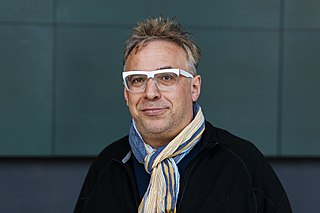
Chiptune is a style of electronic music made using the programmable sound generator (PSG) sound chips or synthesizers in vintage arcade machines, computers and video game consoles. The term is commonly used to refer to tracker format music using extremely basic and small samples that an old computer or console could produce, as well as music that combines PSG sounds with modern musical styles. It has been described as "an interpretation of many genres" since any existing song can be arranged in a chiptune style defined more by choice of instrument and timbre than specific style elements.

Bodenständig 2000 is an electronic music group from Germany, founded in 1995 by Dragan Espenschied and Bernhard Kirsch. They are the self-proclaimed pioneers of the home computer folk music movement.

The New Museum of Contemporary Art is a museum at 235 Bowery, on the Lower East Side of Manhattan in New York City. It was founded in 1977 by Marcia Tucker.

Lev Manovich is an artist, an author and a theorist of digital culture. He is a Distinguished Professor at the Graduate Center of the City University of New York. Manovich played a key role in creating four new research fields: new media studies (1991-), software studies (2001-), cultural analytics (2007-) and AI aesthetics (2018-). Manovich's current research focuses on generative media, AI culture, digital art, and media theory.

Cory Arcangel is an American post-conceptual artist who makes work in many different media, including drawing, music, video, performance art, and video game modifications, for which he is best known.
G. H. Hovagimyan is an American experimental cross-media, new media art and performance artist who lives and works in New York City.
Eyebeam is a not-for-profit art and technology center in New York City, founded by John Seward Johnson III with co-founders David S. Johnson and Roderic R. Richardson.
The conservation and restoration of new media art is the study and practice of techniques for sustaining new media art created using from materials such as digital, biological, performative, and other variable media.

Olia Lialina is an Internet artist and theorist, an experimental film and video critic and curator.
Yael Kanarek is an Israeli American artist based in New York City that is known for pioneering use of the Internet and of multilingualism in work of art.
Rhizome is an American not-for-profit arts organization that supports and provides a platform for new media art.

Teo Spiller is a Slovenian digital artist who has been active in the net.art movement since 1995. Spiller is notable for being one of the first artists to sell a piece of Internet art to a museum or collector. As of March 2018 he was an assistant professor at Arthouse College in Ljubljana.
Tom Moody was an American visual artist, critic and blogger based in New York City. He began his career as a painter, using traditional materials, but became sensitive to the chemicals. In the mid-1990s, upon moving to New York, he began working with MS Paintbrush during downtime at a day job and continued using this software throughout his life, despite more sophisticated programs such as Photoshop being widely available. Later works made use of animated GIF files.

Internet art is a form of new media art distributed via the Internet. This form of art circumvents the traditional dominance of the physical gallery and museum system. In many cases, the viewer is drawn into some kind of interaction with the work of art. Artists working in this manner are sometimes referred to as net artists.
My Boyfriend Came Back From the War is a browser-based internet artwork created in 1996 by Russian artist Olia Lialina.

Goto80 is a Swedish music artist and researcher. He has been described as one of the key players between glitch and chipmusic, as well as an active demoscener. At the turn of the millennium he was one of the first to bring chipmusic to a wider audience, and was also an early adopter of live Game Boy music. He has an extensive back catalogue of free music – often open source – with a wide span of musical influences. He currently focuses on research and art, and maintains a number of blogs and labels such as Chipflip and the text-mode tumblr.
Ryder Ripps is an American conceptual artist, programmer, and creative director.

Lindsay Howard is an American curator, writer, and new media scholar based in New York City whose work explores how the internet is shaping art and culture.
Patrick Lichty is a conceptual media artist, activist, curator, and educator. Lichty is currently a Creative Digital Media professor at Winona State University.
Pat Badani is a Canadian-American interdisciplinary artist, writer/editor, and researcher whose works promote ecological balance and sustainable human-world relations. She is best known for utopian/dystopian themes in works dealing with human migration, globalization, connections between food and cultures, and sustainability. Art projects often include culinary art, photography, installation, digital art, internet art, mobile apps, and creative writing. Articles about her work have appeared in art magazines, in journals (Leonardo), and in book chapters. She is a board member of the International Symposium on Electronic Art since 2017, and former editor-in-chief of Media-N, Journal of the New Media Caucus (2010-2016), an academic art journal published in the U.S.A.










